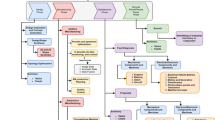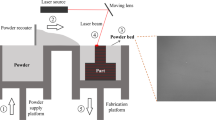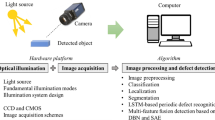Abstract
This paper proposes a fully automated vision system to inspect the whole surface of crankshafts, based on the magnetic particle testing technique. A stepper motor combined with multiple cameras is needed to ensure the inspection of the whole surface of the crankshaft in real-time. Due to the very textured surface of crankshafts and the variability in defect shapes and types, defect detection methods based on deep learning algorithms, more precisely convolutional neural networks (CNNs), become a more efficient solution than traditional methods. This paper discusses the various approaches of defect detection with CNNs, mainly classification, object detection, and semantic segmentation. The advantages and weaknesses of each approach for real-time defect detection are presented. It is important to note that the proposed visual inspection system only replaces the manual inspection of crankshafts conducted by operators at the end of the magnetic particle testing procedure, allowing for an easy integration in any crankshaft factory.











Similar content being viewed by others
References
Fonte M, Duarte P, Reis L, Freitas M, Infante V (2015) Failure mode analysis of two crankshafts of a single cylinder diesel engine. Eng Failure Anal 56:185–193. The sixth international conference on engineering failure analysis
Villanueva JB, Espadafor FJ, Cruz-Peragon F, García MT (2011) A methodology for cracks identification in large crankshafts. Mechan Syst Signal Process 25(8):3168–3185
McEvily A (2004) Failures in inspection procedures: Case studies. Eng Failure Anal 11(2):167–176
Espadafor FJ, Villanueva JB, García MT (2009) Analysis of a diesel generator crankshaft failure. Eng Fail Anal 16(7):2333–2341
Vetterlein T (2008) Application of magnetic particle inspection in the field of the automotive industry. In: Abstracts of 17th world conference on non-destructive testing
Guerra AS, Pillet M, Maire JL (2008) Control of variability for man measurement. In: 12th IMEKO TC1-TC7 joint symposium on man, science and measurement, p. nc. annecy, France
Maire JL, Pillet M, Baudet N (2013) Gage r2&e2: An effective tool to improve the visual control of products. Int J Qual Reliab Manag 30(2):161–176
Kopardekar P, Mital A, Anand S (1993) Manual, hybrid and automated inspection literature and current research. Integr Manuf Syst 4(1):18–29
Neogi N, Mohanta DK, Dutta PK (2014) Review of vision-based steel surface inspection systems. EURASIP J Image Video Process 2014(1):50
Koch C, Georgieva K, Kasireddy V, Akinci B, Fieguth P (2015) A review on computer vision based defect detection and condition assessment of concrete and asphalt civil infrastructure. Adv Eng Inform 29(2):196–210
Cao W, Liu Q, He Z (2020) Review of pavement defect detection methods. IEEE Access 8:14531–14544
Hanbay K, Talu MF, Özgüven ÖF (2016) Fabric defect detection systems and methods–a systematic literature review. Optik 127(24):11960–11973
Ehret T, Davy A, Morel JM, Delbracio M (2019) Image anomalies: A review and synthesis of detection methods. J Math Imaging Vision 61(5):710–743
Zhou F, Liu G, Xu F, Deng H (2019) A generic automated surface defect detection based on a bilinear model. Appl Sci 9(15):3159
Tout K, Cogranne R, Retraint F (2018) Statistical decision methods in the presence of linear nuisance parameters and despite imaging system heteroscedastic noise: Application to wheel surface inspection. Signal Process 144:430–443
Tao X, Zhang D, Ma W, Liu X, Xu D (2018) Automatic metallic surface defect detection and recognition with convolutional neural networks. Appl Sci 8(9):1575
LeCun Y, Bengio Y, Hinton G (2015) Deep learning. Nature 521(7553):436
Ferguson MK, Ronay A, Lee YTT, Law KH (2018) Detection and segmentation of manufacturing defects with convolutional neural networks and transfer learning. Smart Sustain Manufact Syst 2
Hou W, Wei Y, Guo J, Jin Y, et al. (2018) Automatic detection of welding defects using deep neural network. In: Journal of physics: Conference series, vol 933. IOP Publishing, p 012006
Ye J, Ito S, Toyama N (2018) Computerized ultrasonic imaging inspection: from shallow to deep learning. Sensors 18(11):3820
Luo Q, Gao B, Woo WL, Yang Y (2019) Temporal and spatial deep learning network for infrared thermal defect detection. NDT E Int 108:102164
Tabernik D, Šela S, Skvarč J, Skočaj D (2020) Segmentation-based deep-learning approach for surface-defect detection. J Intell Manufact 31(3):759–776
Bastian BT, Jaspreeth N, Ranjith SK, Jiji C (2019) Visual inspection and characterization of external corrosion in pipelines using deep neural network. NDT E Int 102134:107
Dung CV, Sekiya H, Hirano S, Okatani T, Miki C (2019) A vision-based method for crack detection in gusset plate welded joints of steel bridges using deep convolutional neural networks. Autom Constr 102:217–229
Lv X, Duan F, Jiang JJ, Fu X, Gan L (2020) Deep metallic surface defect detection: The new benchmark and detection network. Sensors 20(6):1562
Lin CY, Chen CH, Yang CY, Akhyar F, Hsu CY, Ng HF (2019) Cascading convolutional neural network for steel surface defect detection. In: International conference on applied human factors and ergonomics. Springer, New York, pp 202–212
Bamberger H, Hong E, Katz R, Agapiou JS, Smyth SM (2012) Non-contact, in-line inspection of surface finish of crankshaft journals. Int J Adv Manufact Technol 60(9-12):1039–1047
Iborra A, Alvarez B, Jimenez C, Fernandez-Merono J, Fernandez C, Suardiaz J (2000) Automated visual inspection system (avi) for crankshaft production processes. Europ J Mechan Environ Eng 45 (1):29–34
Remeseiro B, Tarrío-saavedra J, Francisco-Fernández M, Penedo MG, Naya S, Cao R (2019) Automatic detection of defective crankshafts by image analysis and supervised classification. Int J Adv Manufact Technol 105(9):3761–3777
Myagkov L, Mahkamov K, Chainov N, Makhkamova I (2014) 11 - advanced and conventional internal combustion engine materials. In: Folkson R (ed) Alternative fuels and advanced vehicle technologies for improved environmental performance. Woodhead publishing, pp 370–408e
Chandna P, Chandra A (2009) Quality tools to reduce crankshaft forging defects: An industrial case study. J Indust Syst Eng (JISE)
Witek L, Sikora M, Stachowicz F, Trzepiecinski T (2017) Stress and failure analysis of the crankshaft of diesel engine. Eng Fail Anal 82:703–712
Metkar R, Sunnapwar V, Hiwase S (2011) A fatigue analysis and life estimation of crankshaft-a review. Int J Mechan Mater Eng 6(3):425–430
Bhaumik S, Rangaraju R, Venkataswamy M, Bhaskaran T, Parameswara M (2002) Fatigue fracture of crankshaft of an aircraft engine. Eng Fail Anal 9(3):255–263
Pandey R (2003) Failure of diesel-engine crankshafts. Eng Failure Anal 10(2):165–175
Maass M, Deutsch WAK, Bartholomai F (2012) State of the art mt and ut test stations in the german automotive industry. In: Fall conference & quality testing show 2012, pp 2–6
Nishimine T, Tsuyama O, Tanaka T, Fujiwara H (1995) Automatic magnetic particle testing system for square billets. In: Industry applications conference, 1995. Thirtieth IAS annual meeting, IAS ’95., conference record of the 1995 IEEE, vol 2, pp 1585–1590 vol 2
Luo J, Tian Z, Yang J (2014) Fluorescent magnetic particle inspection device based on digital image processing. In: Proceeding of the 11th world congress on intelligent control and automation, pp 5677–5681
Ewert U, Jaenisch GR, Osterloh K, Zscherpel U, Bathias C, Hentschel M, Erhard A, Goebbels J, Hanselka H, Nuffer J, Daum W (2006) Performance control and condition monitoring. Springer, Berlin, pp 831–912
Hellier C, Hellier C (2013) Handbook of nondestructive evaluation, 2nd edn. McGraw-Hill handbooks McGraw-Hill Education
Goodfellow I, Bengio Y, Courville A (2016) Deep learning. MIT Press, Cambridge. http://www.deeplearningbook.org
He K, Zhang X, Ren S, Sun J (2016) Deep residual learning for image recognition. In: Proceedings of the IEEE conference on computer vision and pattern recognition, pp 770–778
Russakovsky O, Deng J, Su H, Krause J, Satheesh S, Ma S, Huang Z, Karpathy A, Khosla A, Bernstein M et al (2015) Imagenet large scale visual recognition challenge. Int J Comput Vision 115(3):211–252
Srivastava N, Hinton G, Krizhevsky A, Sutskever I, Salakhutdinov R (2014) Dropout: A simple way to prevent neural networks from overfitting. J Mach Learn Res 15(1):1929–1958
Kotsiantis S, Kanellopoulos D, Pintelas P, et al. (2006) Handling imbalanced datasets: A review. GESTS Int Trans Comput Sci Eng 30(1):25–36
Pan SJ, Yang Q (2009) A survey on transfer learning. IEEE Trans Knowl Data Eng 22 (10):1345–1359
Zhao Z, Zheng P, Xu S, Wu X (2019) Object detection with deep learning: A review. IEEE Trans Neural Netw Learn Syst 1–21 https://doi.org/10.1109/TNNLS.2018.2876865
Liu W, Anguelov D, Erhan D, Szegedy C, Reed S, Fu CY, Berg AC (2016) Ssd: Single shot multibox detector. In: European conference on computer vision. Springer, New York, pp 21–37
Simonyan K, Zisserman A (2014) Very deep convolutional networks for large-scale image recognition
Everingham M, Van Gool L, Williams CK, Winn J, Zisserman A (2010) The pascal visual object classes (voc) challenge. Int J Comput Vision 88(2):303–338
Ferguson M, Ak R, Lee YTT, Law KH (2017) Automatic localization of casting defects with convolutional neural networks. In: 2017 IEEE international conference on big data (big data). IEEE, pp 1726–1735
Lateef F, Ruichek Y (2019) Survey on semantic segmentation using deep learning techniques. Neurocomputing 338:321–348. https://doi.org/10.1016/j.neucom.2019.02.003
Ronneberger O, Fischer P, Brox T (2015) U-net: Convolutional networks for biomedical image segmentation. In: International conference on medical image computing and computer-assisted intervention. Springer, New York, pp 234–241
Ioffe S, Szegedy C (2015) Batch normalization: Accelerating deep network training by reducing internal covariate shift
Milletari F, Navab N, Ahmadi SA (2016) V-net: Fully convolutional neural networks for volumetric medical image segmentation. In: 2016 Fourth international conference on 3d vision (3DV). IEEE, pp 565–571
Yu T, Zhu H (2020) Hyper-parameter optimization: A review of algorithms and applications. arXiv:2003.05689
Funding
This work was supported by the TRAC project, grant FUI 24 by the Unique Inter-ministerial Fund.
Author information
Authors and Affiliations
Corresponding author
Ethics declarations
Conflict of interest
The authors declare that they have no competing interests.
Consent to publish
Consent is given to publish.
Ethical approval
The manuscript contains original ideas which have never been published before in other journals.
Consent to participate
Consent is given to participate.
Additional information
Publisher’s note
Springer Nature remains neutral with regard to jurisdictional claims in published maps and institutional affiliations.
Author’s contributions
All authors contributed in writing and revising the manuscripts.
Rights and permissions
About this article
Cite this article
Tout, K., Meguenani, A., Urban, JP. et al. Automated vision system for magnetic particle inspection of crankshafts using convolutional neural networks. Int J Adv Manuf Technol 112, 3307–3326 (2021). https://doi.org/10.1007/s00170-020-06467-4
Received:
Accepted:
Published:
Issue Date:
DOI: https://doi.org/10.1007/s00170-020-06467-4




